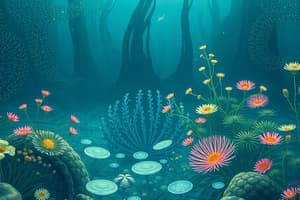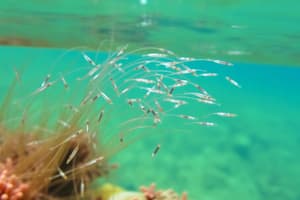Podcast
Questions and Answers
What is the typical tolerance range for reproductive individuals compared to non-reproducing adults?
What is the typical tolerance range for reproductive individuals compared to non-reproducing adults?
- The same for both
- It varies depending on the species
- Narrower for reproductive individuals (correct)
- Wider for reproductive individuals
Why can't blue crab species reproduce in river environments?
Why can't blue crab species reproduce in river environments?
- Rivers lack food for larvae
- Adults can't tolerate brackish water
- Larvae can't tolerate brackish water (correct)
- Adults can't lay eggs in rivers
What do the prefixes 'steno' and 'eury' refer to in ecology?
What do the prefixes 'steno' and 'eury' refer to in ecology?
- Degrees of tolerance (correct)
- Environmental factors
- Types of habitat
- Types of species
What is the term for an organism that can tolerate a wide range of temperatures?
What is the term for an organism that can tolerate a wide range of temperatures?
What is the temperature range in which most species can exist?
What is the temperature range in which most species can exist?
What is the term for an organism that can tolerate a narrow range of salinity?
What is the term for an organism that can tolerate a narrow range of salinity?
What is the primary mechanism of dispersal for most animals?
What is the primary mechanism of dispersal for most animals?
What is the term for an organism that can tolerate a wide range of food sources?
What is the term for an organism that can tolerate a wide range of food sources?
What is the broader concept that includes physical factors as limiting factors?
What is the broader concept that includes physical factors as limiting factors?
Why do plants rely on dispersal vectors?
Why do plants rely on dispersal vectors?
What is the result of fertilization in coral reproduction?
What is the result of fertilization in coral reproduction?
How do motile animals achieve dispersal?
How do motile animals achieve dispersal?
What is the mode of seed dispersal in which seeds are carried away by animals?
What is the mode of seed dispersal in which seeds are carried away by animals?
What is the purpose of dispersal units in non-motile animals?
What is the purpose of dispersal units in non-motile animals?
What is the term for the movement or transport of seeds away from the parent plant?
What is the term for the movement or transport of seeds away from the parent plant?
What is the characteristic that distinguishes non-motile animals?
What is the characteristic that distinguishes non-motile animals?
What is the term for maintaining a fairly constant temperature independent of external temperatures?
What is the term for maintaining a fairly constant temperature independent of external temperatures?
Which of the following groups of animals generate heat metabolically to regulate temperature?
Which of the following groups of animals generate heat metabolically to regulate temperature?
What is the term for acquiring heat primarily from the external environment?
What is the term for acquiring heat primarily from the external environment?
Which group of animals regulates body temperature by endothermy at some times and ectothermy at other times?
Which group of animals regulates body temperature by endothermy at some times and ectothermy at other times?
What is the term for a variable body temperature?
What is the term for a variable body temperature?
Which of the following factors is often responsible for the zonation and stratification of land and water environments?
Which of the following factors is often responsible for the zonation and stratification of land and water environments?
What is the term for the maintenance of a constant temperature through internal heat production?
What is the term for the maintenance of a constant temperature through internal heat production?
Which of the following organisms are able to live and reproduce in hot springs where the temperature is close to the boiling point?
Which of the following organisms are able to live and reproduce in hot springs where the temperature is close to the boiling point?
What is the maximum number of individuals that the environment can support?
What is the maximum number of individuals that the environment can support?
What happens to the population growth rate as the population approaches its carrying capacity?
What happens to the population growth rate as the population approaches its carrying capacity?
What is the term used to describe the growth and reproductive strategies of various organisms?
What is the term used to describe the growth and reproductive strategies of various organisms?
What is characteristic of K-selected species?
What is characteristic of K-selected species?
What is the equation that describes the logistic growth of a population?
What is the equation that describes the logistic growth of a population?
What is the main difference between r-selected and K-selected species?
What is the main difference between r-selected and K-selected species?
Which of the following is NOT a characteristic of K-selected species?
Which of the following is NOT a characteristic of K-selected species?
What type of organisms eat both plants and animals?
What type of organisms eat both plants and animals?
What is the term used to describe the resistance that the environment exerts on the population growth?
What is the term used to describe the resistance that the environment exerts on the population growth?
What is the role of decomposers in an ecosystem?
What is the role of decomposers in an ecosystem?
What is the starting point of a grazing food chain?
What is the starting point of a grazing food chain?
What is the significance of studying food chains?
What is the significance of studying food chains?
What is a food web?
What is a food web?
What is the direction of energy flow in an ecosystem?
What is the direction of energy flow in an ecosystem?
What happens to the quantity of energy as it flows through successive trophic levels?
What happens to the quantity of energy as it flows through successive trophic levels?
What type of food chain starts from dead organic matter?
What type of food chain starts from dead organic matter?
Flashcards are hidden until you start studying
Study Notes
Tolerance and Limiting Factors
- The limits of tolerance for reproductive individuals, seeds, eggs, embryos, and larvae are usually narrower than for non-reproducing adult plants or animals.
- Adult blue crab and many other marine animals can tolerate brackish water, but their larvae cannot live in such waters, making it impossible for the species to reproduce in the river environment.
- Terms used to express the relative degree of tolerance:
- Stenothermal: narrow temperature tolerance
- Eurythermal: wide temperature tolerance
- Stenohaline: narrow salinity tolerance
- Euryhaline: wide salinity tolerance
- Stenohydric: narrow water tolerance
- Euryhydric: wide water tolerance
- Stenophagic: narrow food tolerance
- Euryphagic: wide food tolerance
Physical Factors as Limiting Factors
- Temperature is one of the essential environmental factors, and life can only exist within a tiny range of about 300 degrees centigrade (from -200°C to 100°C).
- Most species and most activity are restricted to an even narrower band of temperature.
- Temperature is often responsible for zonation and stratification in both land and water environments.
- Temperature, light, and water largely control the seasonal and daily activities of plants and animals.
Temperature Regulation in Animals
- Animals can be classified into three groups relative to temperature regulation:
- Endotherms (generate heat metabolically): maintain a fairly constant body temperature independent of external temperatures (e.g., birds, mammals).
- Ectotherms (acquire heat from the environment): have a variable body temperature (e.g., fish, amphibians, reptiles, insects, other invertebrates).
- Heterotherms (regulate body temperature by endothermy at some times and ectothermy at other times): have a mix of both endothermic and ectothermic traits.
Dispersal Mechanisms
- Dispersal mechanisms allow organisms to "test" new environments for their suitability.
- Movement is usually guided by inherited behaviors.
- Plant dispersal mechanisms:
- Seed dispersal: movement or transport of seeds away from the parent plant.
- Four main modes of seed dispersal: gravity, wind, water, and by animals.
- Animal dispersal mechanisms:
- Non-motile animals: produce dispersal units, such as specialized "buds" or motile sexual reproduction products.
- Motile animals: majority of animals are motile, and their movements are guided by inherited behaviors.
Population Growth and Reproductive Strategies
- Logistic growth curve: population growth slows down as the carrying capacity is reached, eventually leveling off.
- Carrying capacity (K): maximum number of individuals that the environment can support.
- Logistic growth equation: ΔN/Δt = r max N (K-N/K)
- Reproductive strategies:
- r-selection: species adapted to thrive when the population is growing rapidly.
- K-selection: species adapted to thrive when the population is near its carrying capacity.
- Characteristics of r-selected species:
- Short life
- Faster growth
- Early maturity
- Many, small offspring
- Low parental care and protection
- Adapted to unstable environments
- Low trophic level
- Characteristics of K-selected species:
- Long life
- Slower growth
- Later maturity
- Few, large offspring
- High parental care and protection
- Adapted to stable environments
- High trophic level
Food Chains and Food Webs
- Food chains: linear sequences of organisms that eat other organisms, with each level representing a trophic level.
- Food webs: networks of interconnected food chains in an ecosystem.
- Types of food chains:
- Grazing food chains: start from green plants and move to herbivores and then to carnivores.
- Detritus food chains: start from dead organic matter and move to detrivores and then to carnivores.
- Significance of studying food chains and food webs:
- Understand feeding relationships and interactions among organisms.
- Explain the flow of energy and circulation of materials in ecosystems.
- Help understand the concept of biomagnification in ecosystems.
Studying That Suits You
Use AI to generate personalized quizzes and flashcards to suit your learning preferences.




